High blood pressure and heart rate
VerifiedAdded on 2022/08/08
|11
|2341
|33
AI Summary
PLEASE READ ODF document and follow high distinction marking rubric.
Contribute Materials
Your contribution can guide someone’s learning journey. Share your
documents today.

Running Head: Nursing
Nursing
Name of the student
Name of the University
Authors Note
Nursing
Name of the student
Name of the University
Authors Note
Secure Best Marks with AI Grader
Need help grading? Try our AI Grader for instant feedback on your assignments.
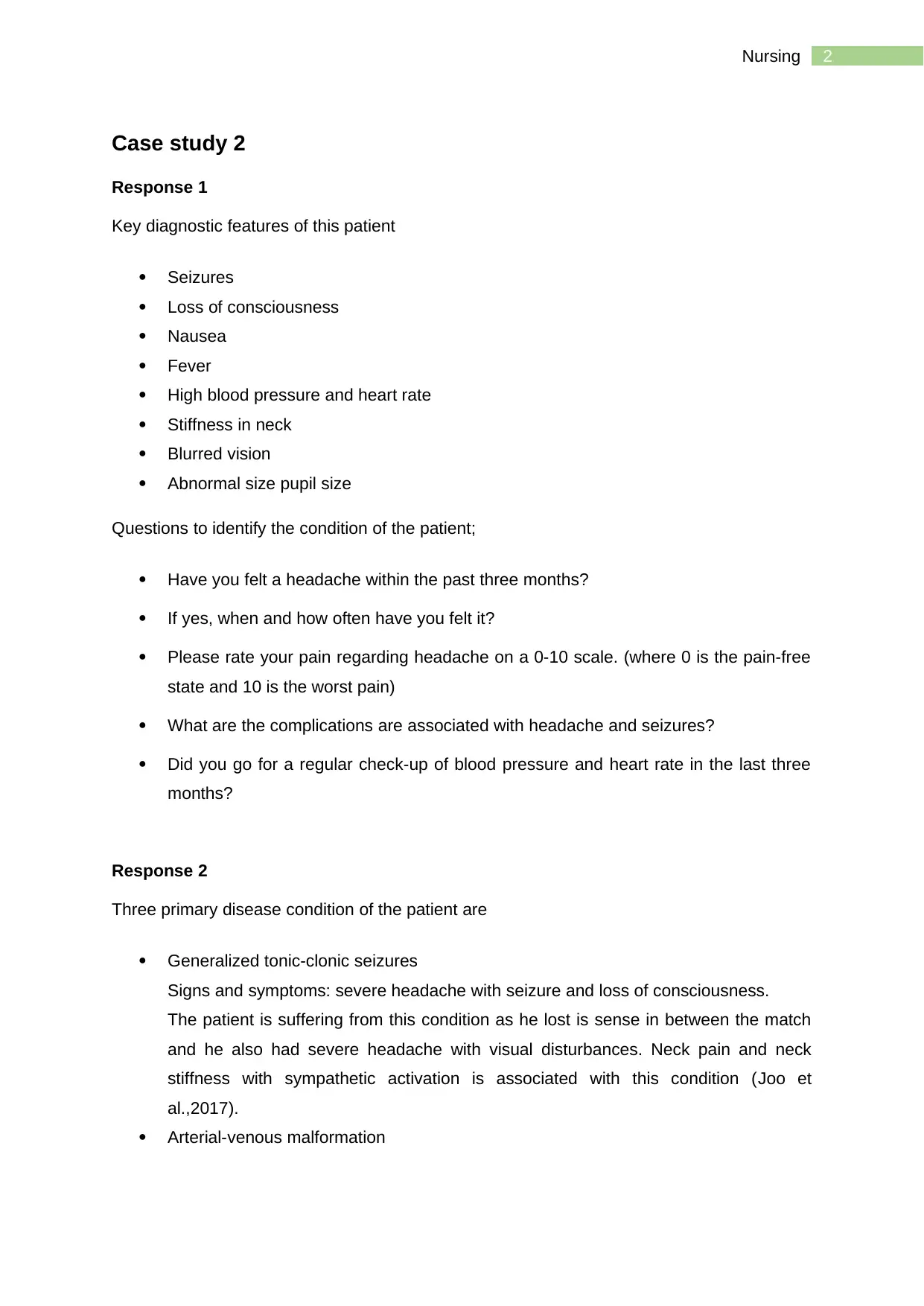
2Nursing
Case study 2
Response 1
Key diagnostic features of this patient
Seizures
Loss of consciousness
Nausea
Fever
High blood pressure and heart rate
Stiffness in neck
Blurred vision
Abnormal size pupil size
Questions to identify the condition of the patient;
Have you felt a headache within the past three months?
If yes, when and how often have you felt it?
Please rate your pain regarding headache on a 0-10 scale. (where 0 is the pain-free
state and 10 is the worst pain)
What are the complications are associated with headache and seizures?
Did you go for a regular check-up of blood pressure and heart rate in the last three
months?
Response 2
Three primary disease condition of the patient are
Generalized tonic-clonic seizures
Signs and symptoms: severe headache with seizure and loss of consciousness.
The patient is suffering from this condition as he lost is sense in between the match
and he also had severe headache with visual disturbances. Neck pain and neck
stiffness with sympathetic activation is associated with this condition (Joo et
al.,2017).
Arterial-venous malformation
Case study 2
Response 1
Key diagnostic features of this patient
Seizures
Loss of consciousness
Nausea
Fever
High blood pressure and heart rate
Stiffness in neck
Blurred vision
Abnormal size pupil size
Questions to identify the condition of the patient;
Have you felt a headache within the past three months?
If yes, when and how often have you felt it?
Please rate your pain regarding headache on a 0-10 scale. (where 0 is the pain-free
state and 10 is the worst pain)
What are the complications are associated with headache and seizures?
Did you go for a regular check-up of blood pressure and heart rate in the last three
months?
Response 2
Three primary disease condition of the patient are
Generalized tonic-clonic seizures
Signs and symptoms: severe headache with seizure and loss of consciousness.
The patient is suffering from this condition as he lost is sense in between the match
and he also had severe headache with visual disturbances. Neck pain and neck
stiffness with sympathetic activation is associated with this condition (Joo et
al.,2017).
Arterial-venous malformation

3Nursing
The patient had severe headache, weakness and temporary loss of vision similar to the
symptoms of arterial-venous malformation.
Cerebro-vascular accident
Loss of balance and coordination, blurred vision and numbness are some prominent
symptoms of cerebro-vascular accident (Ramakrishna, Kumar & Ramakrishna, 2019).
Due to this condition the patient lost his consciousness and felt tremendous neck pain
with stiffness.
Response 3
From the above discussion, it can be intervened that the patient collapsed due to
generalized tonic-clonic seizures and transient ischemic attack or cerebrovascular accident.
Generalized tonic-clonic seizures is caused by focal lesion and Imbalance in
electrical activity. The focal lesions might be occurred due to de-oxygenation and imbalance
in electrolytes in the brain cells. Visual disturbances and headache are generalized tonic-
clonic seizures (appendix, table 1). The symptoms such as nausea, memory loss, fever, and
neck pain with neck stiffness are prominent in generalized tonic-clonic seizures (Halford et
al., 2017). As per the above discussed evidence, patient is suffering from the generalized
tonic-clonic seizures.
Patient might have suffered from Transient Ischemic Attack. Lack of oxygen supply to
the brain and atherosclerosis flux are caused by TIA. For TIA, dizziness and loss of
consciousness with shortness of breath and high respiratory rate can be observed in the
patient(appendix, table 1). TIA can occur in brain due to the high blood pressure in the
vascular system of brain. Abnormal pupil size, nausea, confusion, seizures and loss of vision
are present in the patient of TIA. All the symptoms present in the patient (Amarenco et al.,
2016).
The patient had severe headache, weakness and temporary loss of vision similar to the
symptoms of arterial-venous malformation.
Cerebro-vascular accident
Loss of balance and coordination, blurred vision and numbness are some prominent
symptoms of cerebro-vascular accident (Ramakrishna, Kumar & Ramakrishna, 2019).
Due to this condition the patient lost his consciousness and felt tremendous neck pain
with stiffness.
Response 3
From the above discussion, it can be intervened that the patient collapsed due to
generalized tonic-clonic seizures and transient ischemic attack or cerebrovascular accident.
Generalized tonic-clonic seizures is caused by focal lesion and Imbalance in
electrical activity. The focal lesions might be occurred due to de-oxygenation and imbalance
in electrolytes in the brain cells. Visual disturbances and headache are generalized tonic-
clonic seizures (appendix, table 1). The symptoms such as nausea, memory loss, fever, and
neck pain with neck stiffness are prominent in generalized tonic-clonic seizures (Halford et
al., 2017). As per the above discussed evidence, patient is suffering from the generalized
tonic-clonic seizures.
Patient might have suffered from Transient Ischemic Attack. Lack of oxygen supply to
the brain and atherosclerosis flux are caused by TIA. For TIA, dizziness and loss of
consciousness with shortness of breath and high respiratory rate can be observed in the
patient(appendix, table 1). TIA can occur in brain due to the high blood pressure in the
vascular system of brain. Abnormal pupil size, nausea, confusion, seizures and loss of vision
are present in the patient of TIA. All the symptoms present in the patient (Amarenco et al.,
2016).
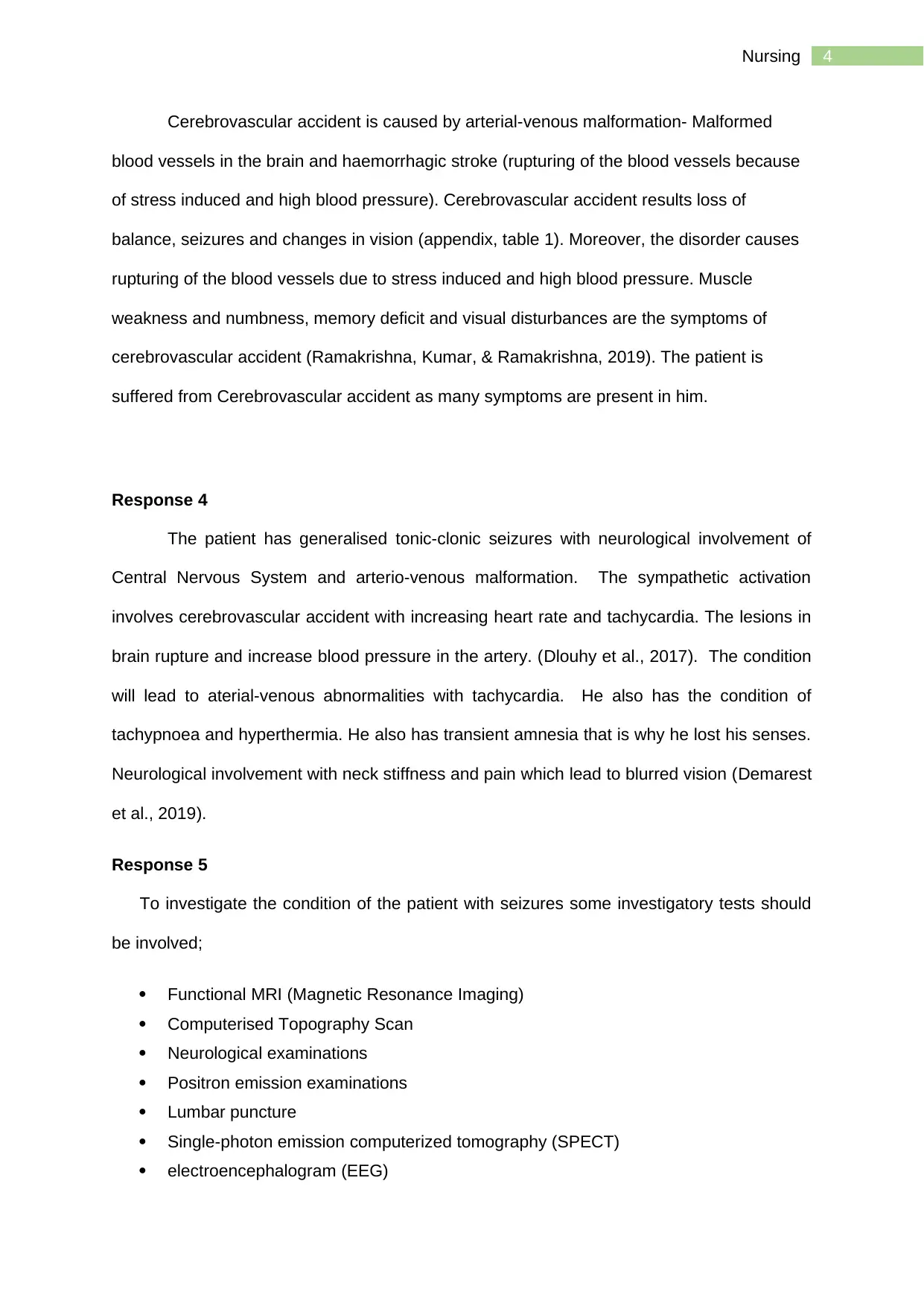
4Nursing
Cerebrovascular accident is caused by arterial-venous malformation- Malformed
blood vessels in the brain and haemorrhagic stroke (rupturing of the blood vessels because
of stress induced and high blood pressure). Cerebrovascular accident results loss of
balance, seizures and changes in vision (appendix, table 1). Moreover, the disorder causes
rupturing of the blood vessels due to stress induced and high blood pressure. Muscle
weakness and numbness, memory deficit and visual disturbances are the symptoms of
cerebrovascular accident (Ramakrishna, Kumar, & Ramakrishna, 2019). The patient is
suffered from Cerebrovascular accident as many symptoms are present in him.
Response 4
The patient has generalised tonic-clonic seizures with neurological involvement of
Central Nervous System and arterio-venous malformation. The sympathetic activation
involves cerebrovascular accident with increasing heart rate and tachycardia. The lesions in
brain rupture and increase blood pressure in the artery. (Dlouhy et al., 2017). The condition
will lead to aterial-venous abnormalities with tachycardia. He also has the condition of
tachypnoea and hyperthermia. He also has transient amnesia that is why he lost his senses.
Neurological involvement with neck stiffness and pain which lead to blurred vision (Demarest
et al., 2019).
Response 5
To investigate the condition of the patient with seizures some investigatory tests should
be involved;
Functional MRI (Magnetic Resonance Imaging)
Computerised Topography Scan
Neurological examinations
Positron emission examinations
Lumbar puncture
Single-photon emission computerized tomography (SPECT)
electroencephalogram (EEG)
Cerebrovascular accident is caused by arterial-venous malformation- Malformed
blood vessels in the brain and haemorrhagic stroke (rupturing of the blood vessels because
of stress induced and high blood pressure). Cerebrovascular accident results loss of
balance, seizures and changes in vision (appendix, table 1). Moreover, the disorder causes
rupturing of the blood vessels due to stress induced and high blood pressure. Muscle
weakness and numbness, memory deficit and visual disturbances are the symptoms of
cerebrovascular accident (Ramakrishna, Kumar, & Ramakrishna, 2019). The patient is
suffered from Cerebrovascular accident as many symptoms are present in him.
Response 4
The patient has generalised tonic-clonic seizures with neurological involvement of
Central Nervous System and arterio-venous malformation. The sympathetic activation
involves cerebrovascular accident with increasing heart rate and tachycardia. The lesions in
brain rupture and increase blood pressure in the artery. (Dlouhy et al., 2017). The condition
will lead to aterial-venous abnormalities with tachycardia. He also has the condition of
tachypnoea and hyperthermia. He also has transient amnesia that is why he lost his senses.
Neurological involvement with neck stiffness and pain which lead to blurred vision (Demarest
et al., 2019).
Response 5
To investigate the condition of the patient with seizures some investigatory tests should
be involved;
Functional MRI (Magnetic Resonance Imaging)
Computerised Topography Scan
Neurological examinations
Positron emission examinations
Lumbar puncture
Single-photon emission computerized tomography (SPECT)
electroencephalogram (EEG)
Secure Best Marks with AI Grader
Need help grading? Try our AI Grader for instant feedback on your assignments.
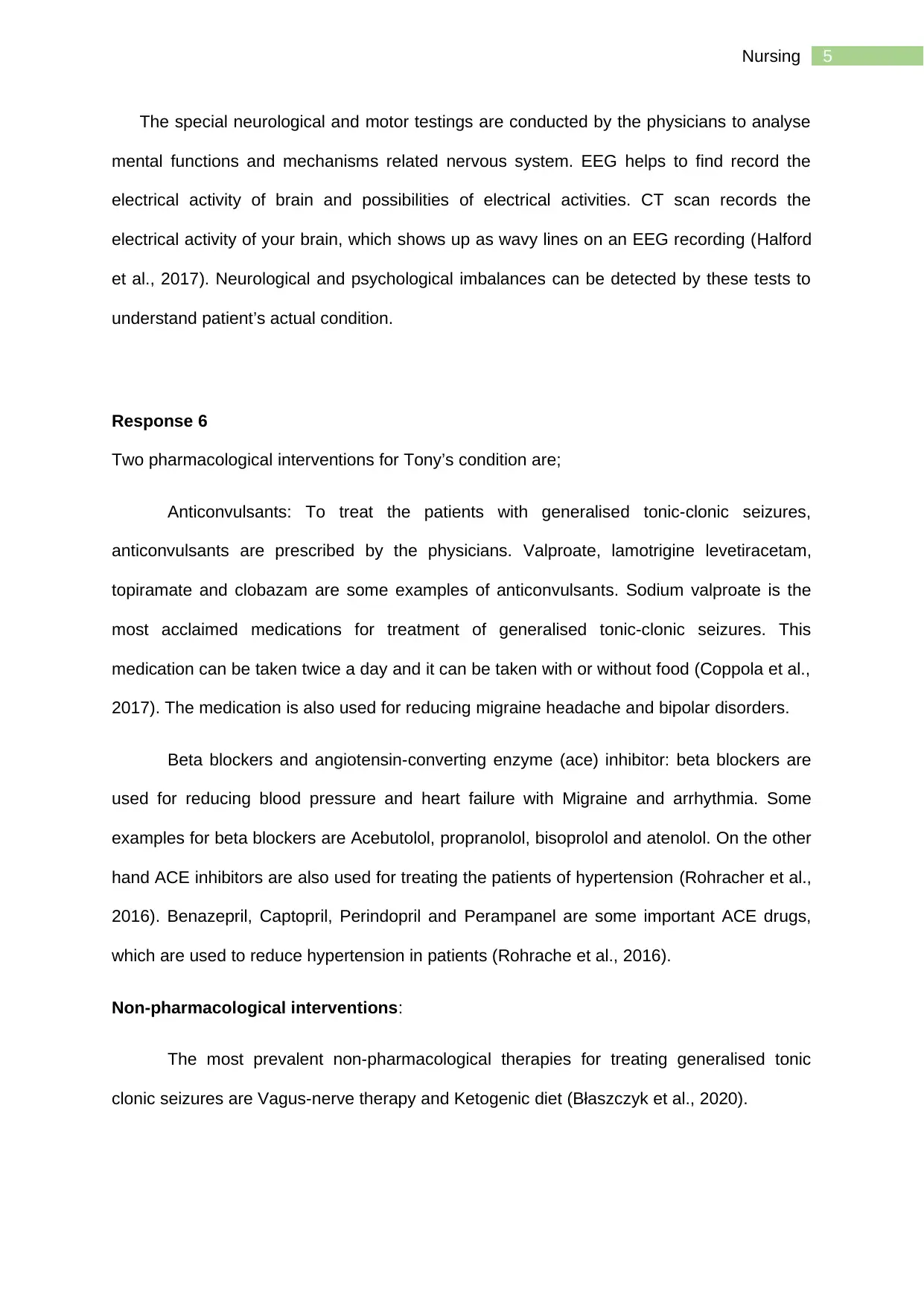
5Nursing
The special neurological and motor testings are conducted by the physicians to analyse
mental functions and mechanisms related nervous system. EEG helps to find record the
electrical activity of brain and possibilities of electrical activities. CT scan records the
electrical activity of your brain, which shows up as wavy lines on an EEG recording (Halford
et al., 2017). Neurological and psychological imbalances can be detected by these tests to
understand patient’s actual condition.
Response 6
Two pharmacological interventions for Tony’s condition are;
Anticonvulsants: To treat the patients with generalised tonic-clonic seizures,
anticonvulsants are prescribed by the physicians. Valproate, lamotrigine levetiracetam,
topiramate and clobazam are some examples of anticonvulsants. Sodium valproate is the
most acclaimed medications for treatment of generalised tonic-clonic seizures. This
medication can be taken twice a day and it can be taken with or without food (Coppola et al.,
2017). The medication is also used for reducing migraine headache and bipolar disorders.
Beta blockers and angiotensin-converting enzyme (ace) inhibitor: beta blockers are
used for reducing blood pressure and heart failure with Migraine and arrhythmia. Some
examples for beta blockers are Acebutolol, propranolol, bisoprolol and atenolol. On the other
hand ACE inhibitors are also used for treating the patients of hypertension (Rohracher et al.,
2016). Benazepril, Captopril, Perindopril and Perampanel are some important ACE drugs,
which are used to reduce hypertension in patients (Rohrache et al., 2016).
Non-pharmacological interventions:
The most prevalent non-pharmacological therapies for treating generalised tonic
clonic seizures are Vagus-nerve therapy and Ketogenic diet (Błaszczyk et al., 2020).
The special neurological and motor testings are conducted by the physicians to analyse
mental functions and mechanisms related nervous system. EEG helps to find record the
electrical activity of brain and possibilities of electrical activities. CT scan records the
electrical activity of your brain, which shows up as wavy lines on an EEG recording (Halford
et al., 2017). Neurological and psychological imbalances can be detected by these tests to
understand patient’s actual condition.
Response 6
Two pharmacological interventions for Tony’s condition are;
Anticonvulsants: To treat the patients with generalised tonic-clonic seizures,
anticonvulsants are prescribed by the physicians. Valproate, lamotrigine levetiracetam,
topiramate and clobazam are some examples of anticonvulsants. Sodium valproate is the
most acclaimed medications for treatment of generalised tonic-clonic seizures. This
medication can be taken twice a day and it can be taken with or without food (Coppola et al.,
2017). The medication is also used for reducing migraine headache and bipolar disorders.
Beta blockers and angiotensin-converting enzyme (ace) inhibitor: beta blockers are
used for reducing blood pressure and heart failure with Migraine and arrhythmia. Some
examples for beta blockers are Acebutolol, propranolol, bisoprolol and atenolol. On the other
hand ACE inhibitors are also used for treating the patients of hypertension (Rohracher et al.,
2016). Benazepril, Captopril, Perindopril and Perampanel are some important ACE drugs,
which are used to reduce hypertension in patients (Rohrache et al., 2016).
Non-pharmacological interventions:
The most prevalent non-pharmacological therapies for treating generalised tonic
clonic seizures are Vagus-nerve therapy and Ketogenic diet (Błaszczyk et al., 2020).
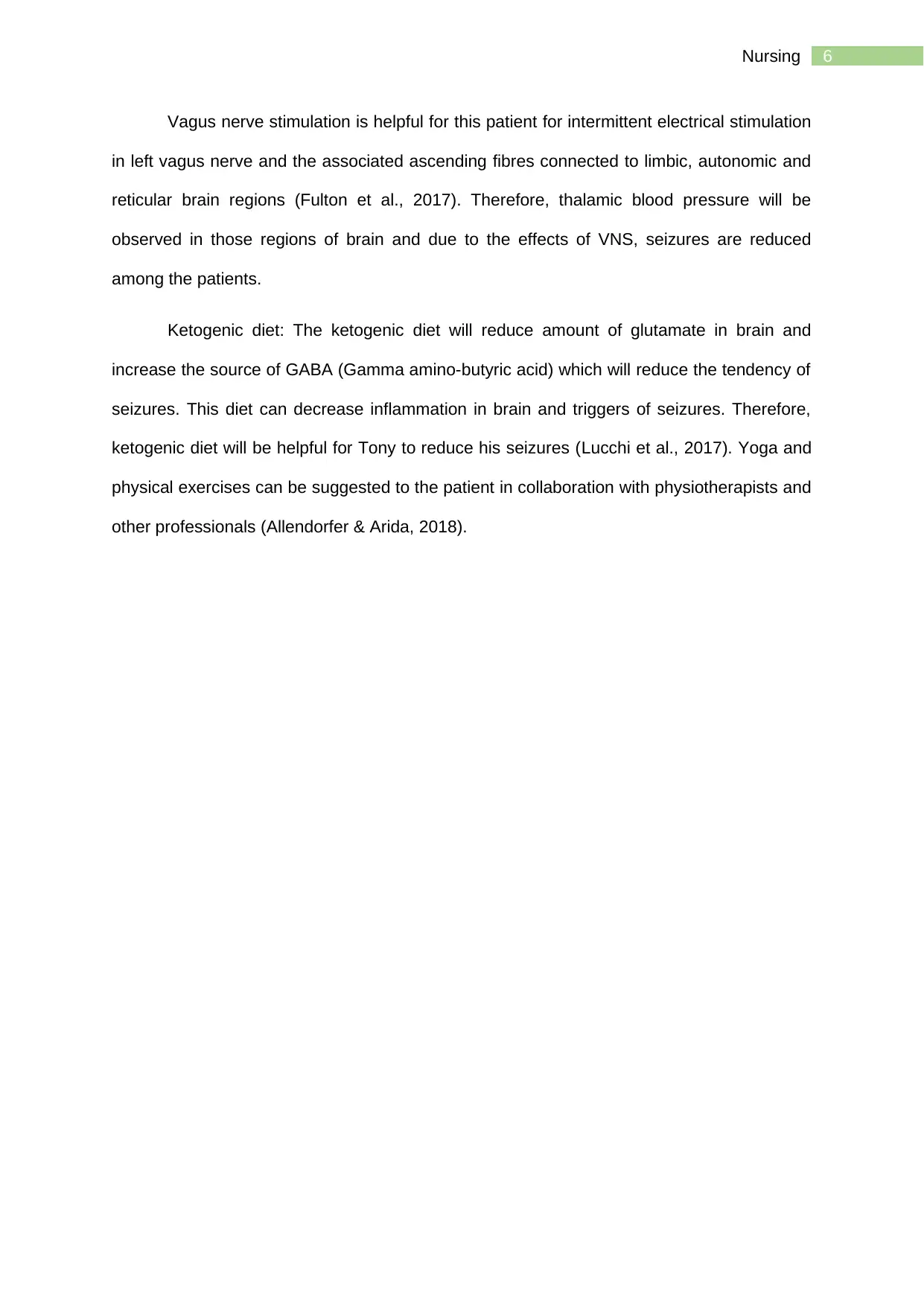
6Nursing
Vagus nerve stimulation is helpful for this patient for intermittent electrical stimulation
in left vagus nerve and the associated ascending fibres connected to limbic, autonomic and
reticular brain regions (Fulton et al., 2017). Therefore, thalamic blood pressure will be
observed in those regions of brain and due to the effects of VNS, seizures are reduced
among the patients.
Ketogenic diet: The ketogenic diet will reduce amount of glutamate in brain and
increase the source of GABA (Gamma amino-butyric acid) which will reduce the tendency of
seizures. This diet can decrease inflammation in brain and triggers of seizures. Therefore,
ketogenic diet will be helpful for Tony to reduce his seizures (Lucchi et al., 2017). Yoga and
physical exercises can be suggested to the patient in collaboration with physiotherapists and
other professionals (Allendorfer & Arida, 2018).
Vagus nerve stimulation is helpful for this patient for intermittent electrical stimulation
in left vagus nerve and the associated ascending fibres connected to limbic, autonomic and
reticular brain regions (Fulton et al., 2017). Therefore, thalamic blood pressure will be
observed in those regions of brain and due to the effects of VNS, seizures are reduced
among the patients.
Ketogenic diet: The ketogenic diet will reduce amount of glutamate in brain and
increase the source of GABA (Gamma amino-butyric acid) which will reduce the tendency of
seizures. This diet can decrease inflammation in brain and triggers of seizures. Therefore,
ketogenic diet will be helpful for Tony to reduce his seizures (Lucchi et al., 2017). Yoga and
physical exercises can be suggested to the patient in collaboration with physiotherapists and
other professionals (Allendorfer & Arida, 2018).
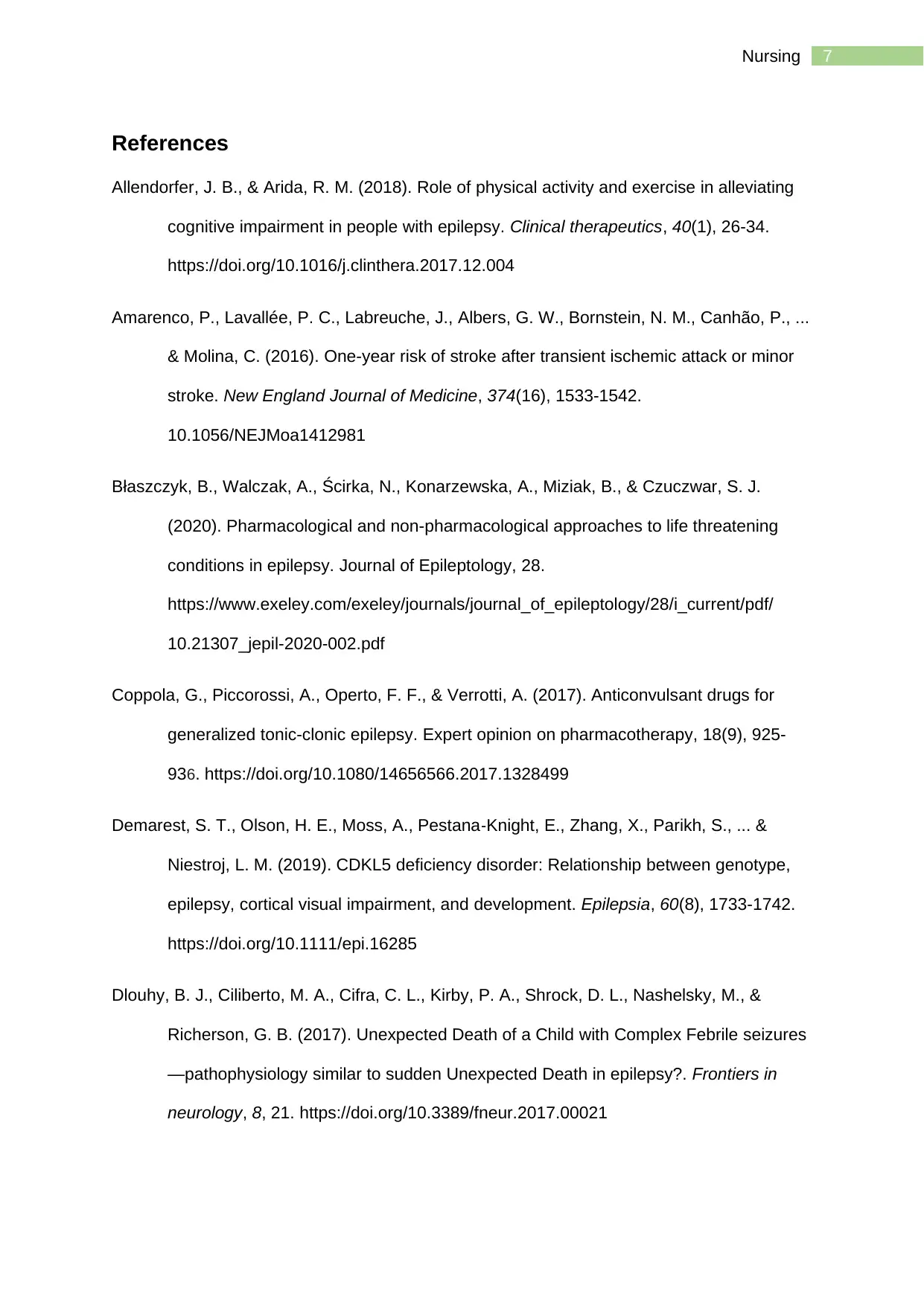
7Nursing
References
Allendorfer, J. B., & Arida, R. M. (2018). Role of physical activity and exercise in alleviating
cognitive impairment in people with epilepsy. Clinical therapeutics, 40(1), 26-34.
https://doi.org/10.1016/j.clinthera.2017.12.004
Amarenco, P., Lavallée, P. C., Labreuche, J., Albers, G. W., Bornstein, N. M., Canhão, P., ...
& Molina, C. (2016). One-year risk of stroke after transient ischemic attack or minor
stroke. New England Journal of Medicine, 374(16), 1533-1542.
10.1056/NEJMoa1412981
Błaszczyk, B., Walczak, A., Ścirka, N., Konarzewska, A., Miziak, B., & Czuczwar, S. J.
(2020). Pharmacological and non-pharmacological approaches to life threatening
conditions in epilepsy. Journal of Epileptology, 28.
https://www.exeley.com/exeley/journals/journal_of_epileptology/28/i_current/pdf/
10.21307_jepil-2020-002.pdf
Coppola, G., Piccorossi, A., Operto, F. F., & Verrotti, A. (2017). Anticonvulsant drugs for
generalized tonic-clonic epilepsy. Expert opinion on pharmacotherapy, 18(9), 925-
936. https://doi.org/10.1080/14656566.2017.1328499
Demarest, S. T., Olson, H. E., Moss, A., Pestana‐Knight, E., Zhang, X., Parikh, S., ... &
Niestroj, L. M. (2019). CDKL5 deficiency disorder: Relationship between genotype,
epilepsy, cortical visual impairment, and development. Epilepsia, 60(8), 1733-1742.
https://doi.org/10.1111/epi.16285
Dlouhy, B. J., Ciliberto, M. A., Cifra, C. L., Kirby, P. A., Shrock, D. L., Nashelsky, M., &
Richerson, G. B. (2017). Unexpected Death of a Child with Complex Febrile seizures
—pathophysiology similar to sudden Unexpected Death in epilepsy?. Frontiers in
neurology, 8, 21. https://doi.org/10.3389/fneur.2017.00021
References
Allendorfer, J. B., & Arida, R. M. (2018). Role of physical activity and exercise in alleviating
cognitive impairment in people with epilepsy. Clinical therapeutics, 40(1), 26-34.
https://doi.org/10.1016/j.clinthera.2017.12.004
Amarenco, P., Lavallée, P. C., Labreuche, J., Albers, G. W., Bornstein, N. M., Canhão, P., ...
& Molina, C. (2016). One-year risk of stroke after transient ischemic attack or minor
stroke. New England Journal of Medicine, 374(16), 1533-1542.
10.1056/NEJMoa1412981
Błaszczyk, B., Walczak, A., Ścirka, N., Konarzewska, A., Miziak, B., & Czuczwar, S. J.
(2020). Pharmacological and non-pharmacological approaches to life threatening
conditions in epilepsy. Journal of Epileptology, 28.
https://www.exeley.com/exeley/journals/journal_of_epileptology/28/i_current/pdf/
10.21307_jepil-2020-002.pdf
Coppola, G., Piccorossi, A., Operto, F. F., & Verrotti, A. (2017). Anticonvulsant drugs for
generalized tonic-clonic epilepsy. Expert opinion on pharmacotherapy, 18(9), 925-
936. https://doi.org/10.1080/14656566.2017.1328499
Demarest, S. T., Olson, H. E., Moss, A., Pestana‐Knight, E., Zhang, X., Parikh, S., ... &
Niestroj, L. M. (2019). CDKL5 deficiency disorder: Relationship between genotype,
epilepsy, cortical visual impairment, and development. Epilepsia, 60(8), 1733-1742.
https://doi.org/10.1111/epi.16285
Dlouhy, B. J., Ciliberto, M. A., Cifra, C. L., Kirby, P. A., Shrock, D. L., Nashelsky, M., &
Richerson, G. B. (2017). Unexpected Death of a Child with Complex Febrile seizures
—pathophysiology similar to sudden Unexpected Death in epilepsy?. Frontiers in
neurology, 8, 21. https://doi.org/10.3389/fneur.2017.00021
Paraphrase This Document
Need a fresh take? Get an instant paraphrase of this document with our AI Paraphraser
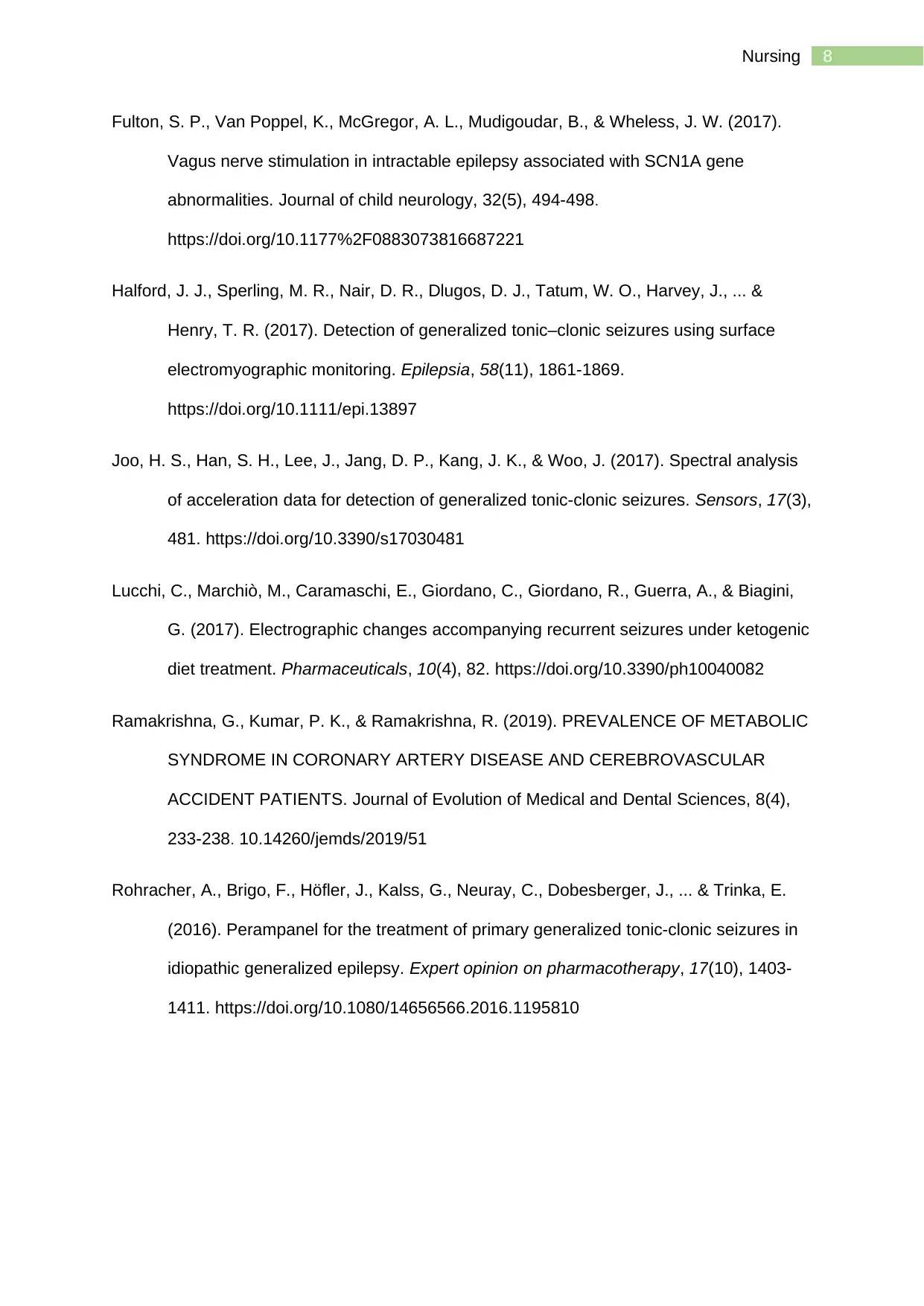
8Nursing
Fulton, S. P., Van Poppel, K., McGregor, A. L., Mudigoudar, B., & Wheless, J. W. (2017).
Vagus nerve stimulation in intractable epilepsy associated with SCN1A gene
abnormalities. Journal of child neurology, 32(5), 494-498.
https://doi.org/10.1177%2F0883073816687221
Halford, J. J., Sperling, M. R., Nair, D. R., Dlugos, D. J., Tatum, W. O., Harvey, J., ... &
Henry, T. R. (2017). Detection of generalized tonic–clonic seizures using surface
electromyographic monitoring. Epilepsia, 58(11), 1861-1869.
https://doi.org/10.1111/epi.13897
Joo, H. S., Han, S. H., Lee, J., Jang, D. P., Kang, J. K., & Woo, J. (2017). Spectral analysis
of acceleration data for detection of generalized tonic-clonic seizures. Sensors, 17(3),
481. https://doi.org/10.3390/s17030481
Lucchi, C., Marchiò, M., Caramaschi, E., Giordano, C., Giordano, R., Guerra, A., & Biagini,
G. (2017). Electrographic changes accompanying recurrent seizures under ketogenic
diet treatment. Pharmaceuticals, 10(4), 82. https://doi.org/10.3390/ph10040082
Ramakrishna, G., Kumar, P. K., & Ramakrishna, R. (2019). PREVALENCE OF METABOLIC
SYNDROME IN CORONARY ARTERY DISEASE AND CEREBROVASCULAR
ACCIDENT PATIENTS. Journal of Evolution of Medical and Dental Sciences, 8(4),
233-238. 10.14260/jemds/2019/51
Rohracher, A., Brigo, F., Höfler, J., Kalss, G., Neuray, C., Dobesberger, J., ... & Trinka, E.
(2016). Perampanel for the treatment of primary generalized tonic-clonic seizures in
idiopathic generalized epilepsy. Expert opinion on pharmacotherapy, 17(10), 1403-
1411. https://doi.org/10.1080/14656566.2016.1195810
Fulton, S. P., Van Poppel, K., McGregor, A. L., Mudigoudar, B., & Wheless, J. W. (2017).
Vagus nerve stimulation in intractable epilepsy associated with SCN1A gene
abnormalities. Journal of child neurology, 32(5), 494-498.
https://doi.org/10.1177%2F0883073816687221
Halford, J. J., Sperling, M. R., Nair, D. R., Dlugos, D. J., Tatum, W. O., Harvey, J., ... &
Henry, T. R. (2017). Detection of generalized tonic–clonic seizures using surface
electromyographic monitoring. Epilepsia, 58(11), 1861-1869.
https://doi.org/10.1111/epi.13897
Joo, H. S., Han, S. H., Lee, J., Jang, D. P., Kang, J. K., & Woo, J. (2017). Spectral analysis
of acceleration data for detection of generalized tonic-clonic seizures. Sensors, 17(3),
481. https://doi.org/10.3390/s17030481
Lucchi, C., Marchiò, M., Caramaschi, E., Giordano, C., Giordano, R., Guerra, A., & Biagini,
G. (2017). Electrographic changes accompanying recurrent seizures under ketogenic
diet treatment. Pharmaceuticals, 10(4), 82. https://doi.org/10.3390/ph10040082
Ramakrishna, G., Kumar, P. K., & Ramakrishna, R. (2019). PREVALENCE OF METABOLIC
SYNDROME IN CORONARY ARTERY DISEASE AND CEREBROVASCULAR
ACCIDENT PATIENTS. Journal of Evolution of Medical and Dental Sciences, 8(4),
233-238. 10.14260/jemds/2019/51
Rohracher, A., Brigo, F., Höfler, J., Kalss, G., Neuray, C., Dobesberger, J., ... & Trinka, E.
(2016). Perampanel for the treatment of primary generalized tonic-clonic seizures in
idiopathic generalized epilepsy. Expert opinion on pharmacotherapy, 17(10), 1403-
1411. https://doi.org/10.1080/14656566.2016.1195810
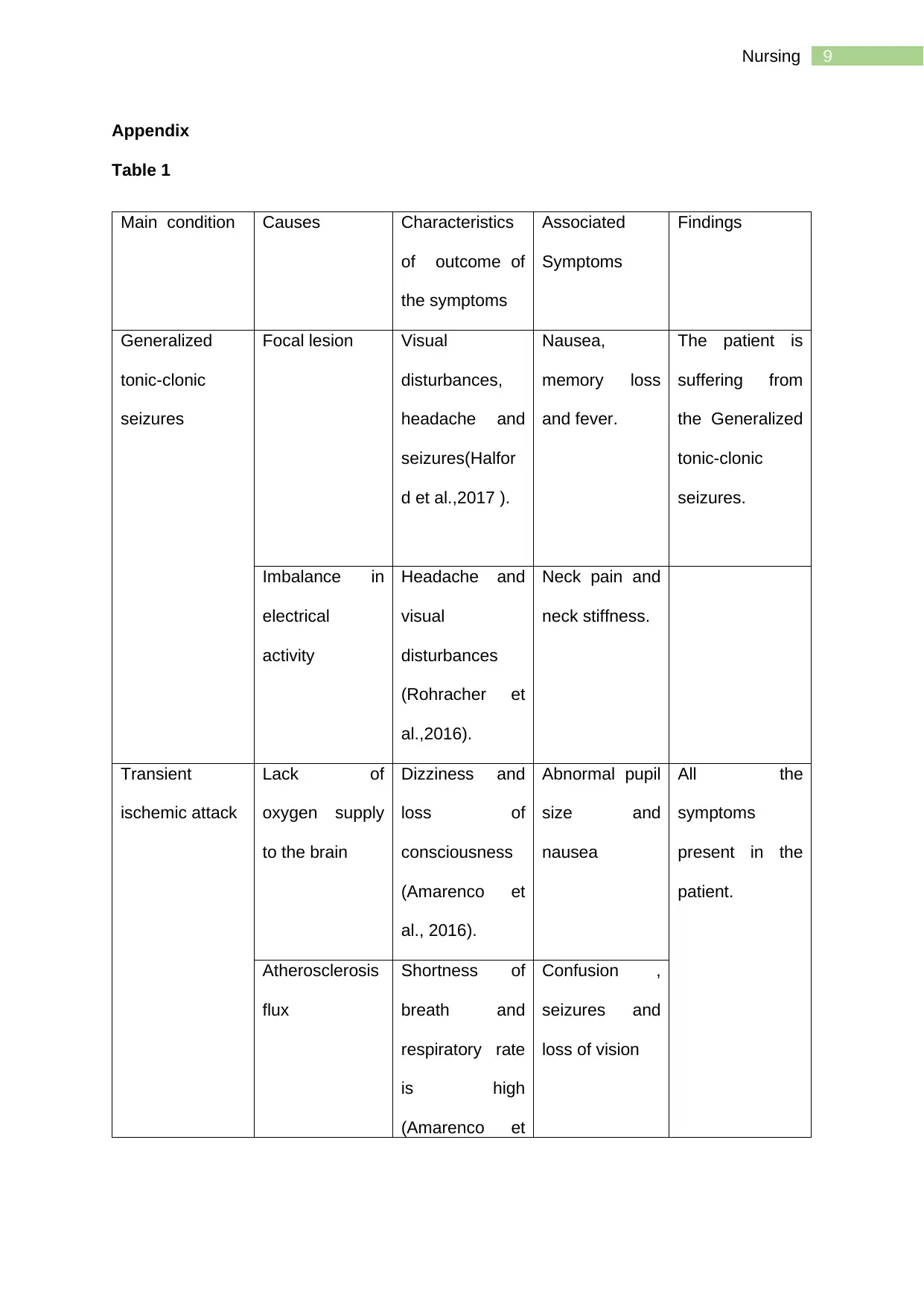
9Nursing
Appendix
Table 1
Main condition Causes Characteristics
of outcome of
the symptoms
Associated
Symptoms
Findings
Generalized
tonic-clonic
seizures
Focal lesion Visual
disturbances,
headache and
seizures(Halfor
d et al.,2017 ).
Nausea,
memory loss
and fever.
The patient is
suffering from
the Generalized
tonic-clonic
seizures.
Imbalance in
electrical
activity
Headache and
visual
disturbances
(Rohracher et
al.,2016).
Neck pain and
neck stiffness.
Transient
ischemic attack
Lack of
oxygen supply
to the brain
Dizziness and
loss of
consciousness
(Amarenco et
al., 2016).
Abnormal pupil
size and
nausea
All the
symptoms
present in the
patient.
Atherosclerosis
flux
Shortness of
breath and
respiratory rate
is high
(Amarenco et
Confusion ,
seizures and
loss of vision
Appendix
Table 1
Main condition Causes Characteristics
of outcome of
the symptoms
Associated
Symptoms
Findings
Generalized
tonic-clonic
seizures
Focal lesion Visual
disturbances,
headache and
seizures(Halfor
d et al.,2017 ).
Nausea,
memory loss
and fever.
The patient is
suffering from
the Generalized
tonic-clonic
seizures.
Imbalance in
electrical
activity
Headache and
visual
disturbances
(Rohracher et
al.,2016).
Neck pain and
neck stiffness.
Transient
ischemic attack
Lack of
oxygen supply
to the brain
Dizziness and
loss of
consciousness
(Amarenco et
al., 2016).
Abnormal pupil
size and
nausea
All the
symptoms
present in the
patient.
Atherosclerosis
flux
Shortness of
breath and
respiratory rate
is high
(Amarenco et
Confusion ,
seizures and
loss of vision
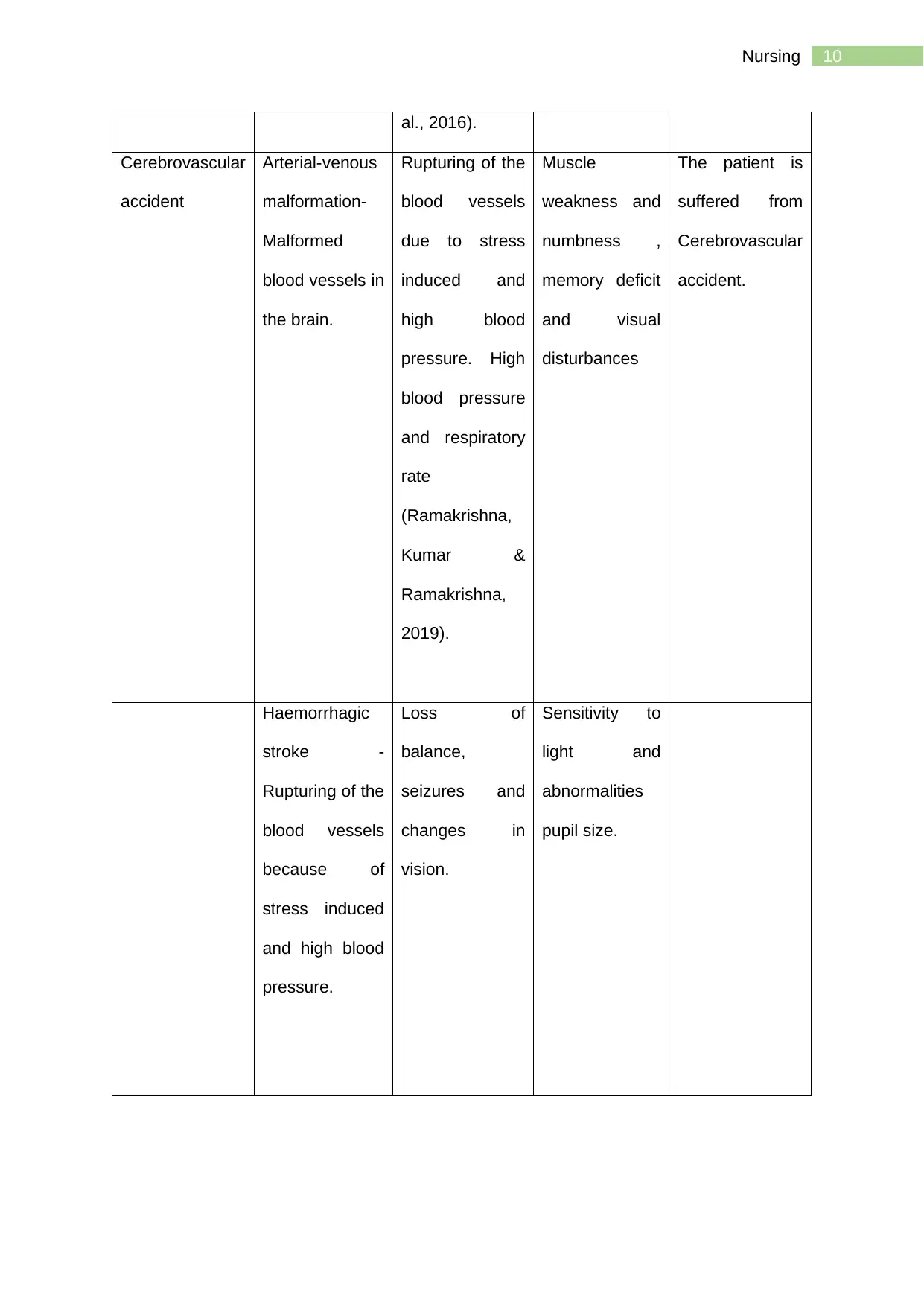
10Nursing
al., 2016).
Cerebrovascular
accident
Arterial-venous
malformation-
Malformed
blood vessels in
the brain.
Rupturing of the
blood vessels
due to stress
induced and
high blood
pressure. High
blood pressure
and respiratory
rate
(Ramakrishna,
Kumar &
Ramakrishna,
2019).
Muscle
weakness and
numbness ,
memory deficit
and visual
disturbances
The patient is
suffered from
Cerebrovascular
accident.
Haemorrhagic
stroke -
Rupturing of the
blood vessels
because of
stress induced
and high blood
pressure.
Loss of
balance,
seizures and
changes in
vision.
Sensitivity to
light and
abnormalities
pupil size.
al., 2016).
Cerebrovascular
accident
Arterial-venous
malformation-
Malformed
blood vessels in
the brain.
Rupturing of the
blood vessels
due to stress
induced and
high blood
pressure. High
blood pressure
and respiratory
rate
(Ramakrishna,
Kumar &
Ramakrishna,
2019).
Muscle
weakness and
numbness ,
memory deficit
and visual
disturbances
The patient is
suffered from
Cerebrovascular
accident.
Haemorrhagic
stroke -
Rupturing of the
blood vessels
because of
stress induced
and high blood
pressure.
Loss of
balance,
seizures and
changes in
vision.
Sensitivity to
light and
abnormalities
pupil size.
Secure Best Marks with AI Grader
Need help grading? Try our AI Grader for instant feedback on your assignments.
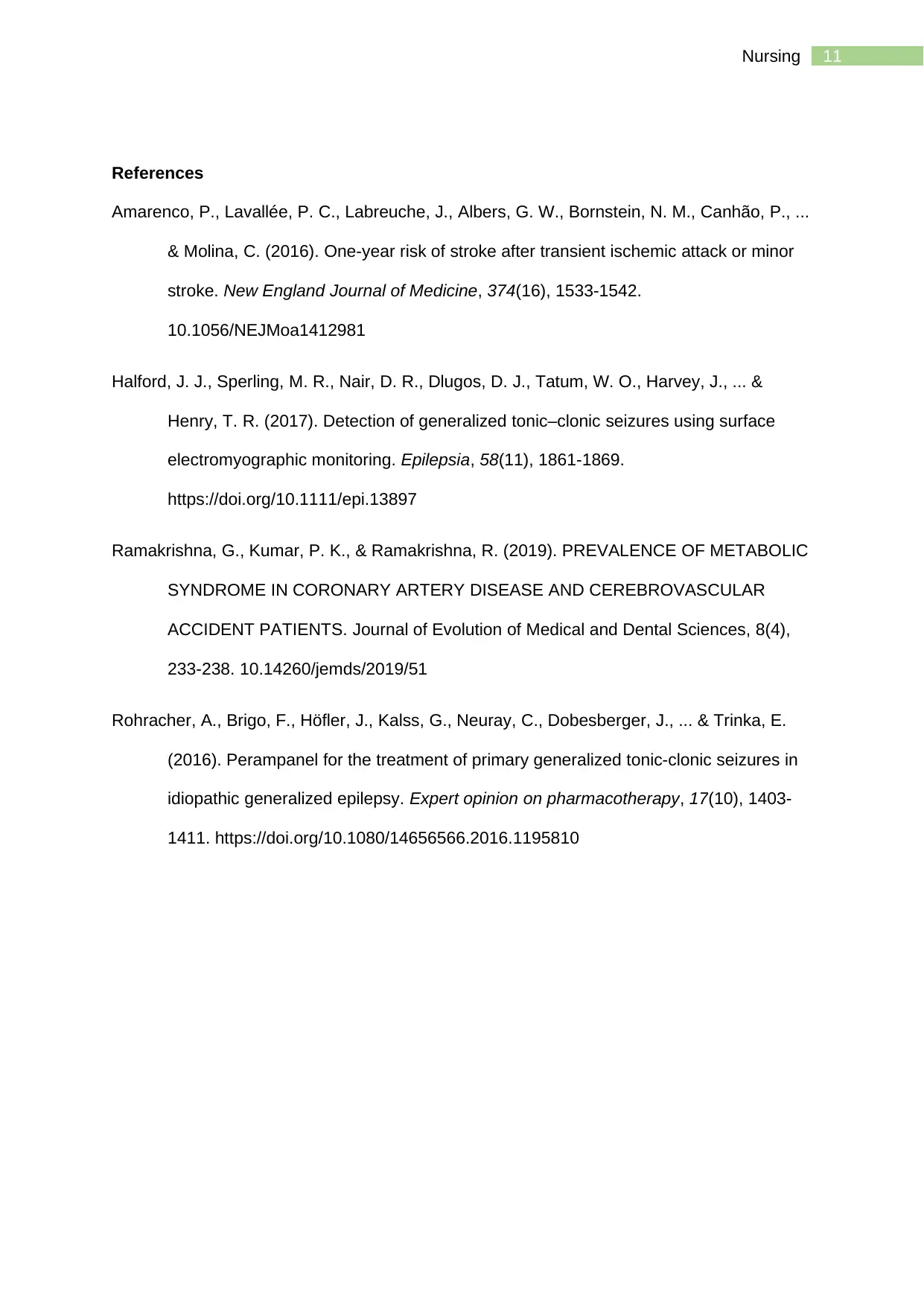
11Nursing
References
Amarenco, P., Lavallée, P. C., Labreuche, J., Albers, G. W., Bornstein, N. M., Canhão, P., ...
& Molina, C. (2016). One-year risk of stroke after transient ischemic attack or minor
stroke. New England Journal of Medicine, 374(16), 1533-1542.
10.1056/NEJMoa1412981
Halford, J. J., Sperling, M. R., Nair, D. R., Dlugos, D. J., Tatum, W. O., Harvey, J., ... &
Henry, T. R. (2017). Detection of generalized tonic–clonic seizures using surface
electromyographic monitoring. Epilepsia, 58(11), 1861-1869.
https://doi.org/10.1111/epi.13897
Ramakrishna, G., Kumar, P. K., & Ramakrishna, R. (2019). PREVALENCE OF METABOLIC
SYNDROME IN CORONARY ARTERY DISEASE AND CEREBROVASCULAR
ACCIDENT PATIENTS. Journal of Evolution of Medical and Dental Sciences, 8(4),
233-238. 10.14260/jemds/2019/51
Rohracher, A., Brigo, F., Höfler, J., Kalss, G., Neuray, C., Dobesberger, J., ... & Trinka, E.
(2016). Perampanel for the treatment of primary generalized tonic-clonic seizures in
idiopathic generalized epilepsy. Expert opinion on pharmacotherapy, 17(10), 1403-
1411. https://doi.org/10.1080/14656566.2016.1195810
References
Amarenco, P., Lavallée, P. C., Labreuche, J., Albers, G. W., Bornstein, N. M., Canhão, P., ...
& Molina, C. (2016). One-year risk of stroke after transient ischemic attack or minor
stroke. New England Journal of Medicine, 374(16), 1533-1542.
10.1056/NEJMoa1412981
Halford, J. J., Sperling, M. R., Nair, D. R., Dlugos, D. J., Tatum, W. O., Harvey, J., ... &
Henry, T. R. (2017). Detection of generalized tonic–clonic seizures using surface
electromyographic monitoring. Epilepsia, 58(11), 1861-1869.
https://doi.org/10.1111/epi.13897
Ramakrishna, G., Kumar, P. K., & Ramakrishna, R. (2019). PREVALENCE OF METABOLIC
SYNDROME IN CORONARY ARTERY DISEASE AND CEREBROVASCULAR
ACCIDENT PATIENTS. Journal of Evolution of Medical and Dental Sciences, 8(4),
233-238. 10.14260/jemds/2019/51
Rohracher, A., Brigo, F., Höfler, J., Kalss, G., Neuray, C., Dobesberger, J., ... & Trinka, E.
(2016). Perampanel for the treatment of primary generalized tonic-clonic seizures in
idiopathic generalized epilepsy. Expert opinion on pharmacotherapy, 17(10), 1403-
1411. https://doi.org/10.1080/14656566.2016.1195810
1 out of 11
Related Documents
Your All-in-One AI-Powered Toolkit for Academic Success.
+13062052269
info@desklib.com
Available 24*7 on WhatsApp / Email
![[object Object]](/_next/static/media/star-bottom.7253800d.svg)
Unlock your academic potential
© 2024 | Zucol Services PVT LTD | All rights reserved.





